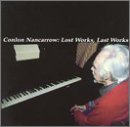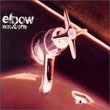| All Artists: Conlon Nancarrow Title: Conlon Nancarrow : Lost Works, Last Works Members Wishing: 2 Total Copies: 0 Label: Other Minds Original Release Date: 3/15/2000 Release Date: 3/15/2000 Genres: Special Interest, Classical Styles: Chamber Music, Forms & Genres, Short Forms, Sonatas, Historical Periods, Classical (c.1770-1830), Modern, 20th, & 21st Century Number of Discs: 1 SwapaCD Credits: 1 UPC: 084390100229 |
Search - Conlon Nancarrow :: Conlon Nancarrow : Lost Works, Last Works
 | Conlon Nancarrow Conlon Nancarrow : Lost Works, Last Works Genres: Special Interest, Classical
|
Larger Image |
CD DetailsSimilar CDs
|
CD ReviewsOnly for the Nancarrow Enthusiast M. Groves | 03/11/2001 (4 out of 5 stars) "This CD contains a couple of Nancarrow's studies not included in the five-volume set on the Wergo label. It contains the Prelude and Blues for Piano, the former in a player piano version, the latter for an interesting contraption created by a composer named Trimpin. This instrument is like a computerized player-marimba, and it is also featured in duet with the player piano on Contraption No. 1. Other tracks include a player piano arrangements of the unplayable Sonatina, and of the String Quartet. The last eight tracks are excerpts from an interview with Charles Amirkhanian.Overall, I think this disk is only worthwhile for the Nancarrow enthusiast. I don't know why the player piano version of the String Quartet No. 1 is included; it has no advantage over the string version. I would have preferred that this record included more of the hard-to-find instrumental music by this composer, such as the second and third string quartets." For the Nancarrow devotee, an indispensable complement to th Discophage | France | 10/24/2007 (5 out of 5 stars) "As the helpfully informative notes explain, this disc collates two kinds of works by Nancarrow: first, the transcriptions he made for player-piano of pieces he had written for "normal" instruments, in order to be able just to hear them (Nancarrow lived in relative isolation in Mexico, ignored from the music world): early composition for normal piano, as the Prelude and the Blues from 1935 and the 1941 Sonatina, as well as the two outer movements from his first String Quartet from 1945, and the Etude #50, a transcription of the second movement of his Piece for Small Orchestra No. 2. It would be entirely misguided to listen to these last two pieces as degraded forms of those from which they derive: forget their origin, they stand in their own right has great, wild studies for player piano. The second kind of pieces featured here are original, early and late compositions. Among the early ones is Nancarrow's unique forray into tape music, a short (and interrupted) 2' piece (of which we get the original tape, made in the fifties, and sounding very much like it) first for drum sounds then wooden percussions that make it sound like Woody Woodpecker gone berzerk (track 8). Another fascinating one is the recording made by Nancarrow himself, somewhere around 1960, of one of his attempts at the prepared player-piano (Study #30, track 9). Ultimately, because he had only upright pianos in which the Cagean fittings couldn't stick, it didn't work and he abandonned the idea. But Study #30 is an exciting and amusing example of a Cage Sonata or Jean Tinguely sculpture gone wild. The others are indeed the last works Nancarrow wrote for the player-piano, after he'd been discovered by the larger music world and supervised the recording in 1988 of the (up-to-then) complete Studies on Wergo: "Para Yoko", Study No. 51 and Contraption No. 1. The latter was in fact written for the "Contraption IPP (Instant Prepared Piano)", a machine that "offers a variety of sound effects at the touch of a button", invented by "Trimpin", a "brilliant, German-born engineer-composer who has done so much for Nancarrow's music", but of whom the notes don't say much else. Go to Wikipedia for more. The recordings have two distinct origins: there are those made by Nancarrow himself at various dates. Other than the two mentioned above, the Piano Sonatina and two movements from the String Quartet were made on one of Nancarrow's two player pianos in April 1977, presumably by Charles Amirkhanian - now executive director of Other Minds, who produced this disc - along with his legendary recording of the (then) complete' studies made for Arch Records. The instrument is apparently the one with wooden hammers with steel strip around them (the other had felt and strip of leather), which ten years later was so run down it could not be used for the Wergo recording: it sounds brittle, giving it a uniquely Nancarrowesque, honky-tonky color, almost like a harpsichord or a Cage prepared piano without preparations (incidentally, in his notes to the Wergo recording Amirkhanian describes it as having "metal-covered FELT hammers", which is contradicted in the interview reproduced on the present disc by Nancarrow himself, who talks of "pure wood, no felt at all"). The other pieces were recorded in 1999 on Trimpin's pianola (souding much more like a normal piano) and, for some of them, on his "Conloninpurple", a computerized marimba with wooden keys hanging from the ceiling above the audience. The otherwise very informative notes by Kyle Gann do not explain why the roll for "Blues" was played on that instrument rather than, as would have seemed more fitting, on the pianola. Indeed, it sounds like an orchestra of wheezy marimbas. As for "Contraption 1", it is not clear whether it is played only on pianola and "Colorinpurple" (which the credits indicate) or also on the instrument it was written for, the Contraption IPP, and again the notes are uninformative here, other than mentioning that Trimpin rescored some of the notes ("bowed sounds too quick to resonate") for computerized marimba with the composer's approval. And the music? Quintessential Nancarrow. It is all there: the crazy boogie-woogies, the limping and out-of-sync rhythms, the cascading, super-human flurries of runs, the wild accelerations, the tonal registers ascending to the heights. Nancarrow sounds like a tape of piano music dubbed at twice the speed. It is immensely exciting and fun. Less than 30 minutes of such extraodinary music makes it a tad frustrating, but the disc is completed by another 30 minutes of excerpts from an interview conducted in 1977 by (the then juvenile-sounding) Amirkhanian. Not everything is interesting - the small talk anecdotes about Rivera and Orozco, the two famous Mexican painters and muralists, could have been left out - and some of the most interesting is unfortunately not on the interview (Nancarrow talks in passing of his interest in "this temporal thing" - indeed the foundation of his compositional approach - but without delving into the matter, only referring to previous conversations with Armikhanian). Also, I find that in some cases Amirkhanian is too present, commenting on Nancarrow rather than letting Nancarrow speak. Still, one can gather fascinating insights - and particularly why Nancarrow became so interested in Canons: because he felt he didn't have too much talent for melody, and a Canon required writing only one, repeated and overlapped so many times over. Also, one simply hears him speak - and he has one maddening verbal mannerism: he cannot begin a phrase or a reply without saying "no", and sometimes "yeah-no, no, no" or "no, yeah !". It probably took a contradicting, rebellious mindset to write the music of Conlon Nancarrow. This is not for the casual Nancarrow listener, who should go to one of the 5 volumes or the complete Wergo set of Studies for Player Piano for starters, but it is indispensable to the Nancarrow devotee. " What is a Conlan Nancarrow enthusiast? Steven Strauss | Oakland, CA USA | 03/21/2006 (4 out of 5 stars) "Some of the music in this recorded program is lovely, in a strange and obstinate way, but I dare say that liking this music pretty much makes one a Conlan Nancarrow enthusiast. The soul who rather enjoys Conlan Nancarrow's singular, difficult music is probably outnumbered by those who would call themselves enthusiasts; the two groups are surely dwarfed by those who cover their ears and run for cover after just a few measures of the average Nancarrow study for mechanical piano.
Contraption #1 stands out for its blending of Nancarrow's signature mechanical piano sounds with Trimpin's mellow mechanical marimba; the two sonorities approximate the tamber of a natural instrumental ensemble, and create a hospitable sonic ambience. Producer Charles Amirkanian's interviews with the composer, excerpted here, are not only edifying, but reveal the maestro to be more fun-loving and affable than the average expatriate genius." |

 Track Listings (14) - Disc #1
Track Listings (14) - Disc #1

